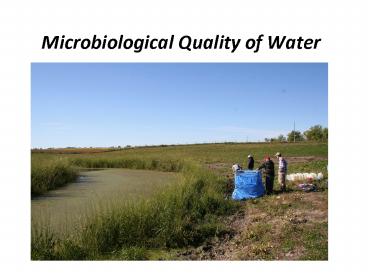Microbiological Quality of Water - PowerPoint PPT Presentation
1 / 26
Title: Microbiological Quality of Water
1
Microbiological Quality of Water
2
Microbial Indicators of Fecal Contamination
- Approach used to evaluate the quality of water
for human use - Quantification of bacteria normally found within
the intestines of warm blooded animals - High numbers is an indication of the presence of
pathogens
3
Criteria for an Ideal Indicator of Fecal
Contamination
- Applicable to all water sources
- Present in stools, sewage water, and water
samples that contain pathogens
4
Criteria for an Ideal Indicator of Fecal
Contamination
- Number correlated to level of fecal contamination
and to number of pathogens - No growth in the environment
- Survival/persistence that is longer than that of
pathogens - Easily detected and quantified
- Numbers associated to the risk of consumers of
contracting enteric diseases
5
Ideal Indicator
- Ex Mooneys Bay ? water quality warnings based
on E.coli levels - Representative of ALL potential sources
- To date no single indicator meets all the criteria
6
Indicators of Fecal Contamination
- Coliform bacteria
- Bacteria of the Enterobacteriaceae family
- Includes 4 genera
- Enterobacter, Klebsiella, Citrobacter, and
Escherichia - Present in the intestine of most warm blooded
animals (humans) - Gram negative rods, non-sporulating
- Ferment lactose with acid and gas production in
48 hours at 37C
7
Fecal Coliforms
- Subset of total coliforms
- Escherichia coli (E. coli)
- Thermotolerant coliforms
- Grow and ferment lactose at 44oC
- Source Fecal material only
- Exception the tropics
8
Fecal Streptococci
- Gram positive
- Mainly associated with animal intestines
- S.faecalis, S.faecium
- Longer survival time than coliforms
- Survive broad range of environmental conditions
ex temperature, pH, salt - The ratio between coliforms and Streptococci is
used to confirm a contamination from human
sources - Ratio Escherichia/Streptococci greater than 0.7
9
Tests for Fecal Contamination
- Selective media
- Allows the growth of certain genera
- Differential media
- Allows the visual discrimination of different
genera
10
Methods
- Presumptive tests
- MPN
- Viable counts
11
Presumptive Tests
- Makes use of differential/selective media to
detect characteristics common to indicator
microorganisms - Positive test presence suspected
- Negative test absence
- Most probable number (MPN)
- Probable number based on a statistical point of
view
12
Lactose Broth
A B C
- Presumptive test for total coliforms
- Differential medium
- Allows to detect lactose fermentation
- pH and gas indicators
13
Presumptive Test for S. faecalis (Enterococcus)
- Selective medium
- Contains azide
- Selective for Enterococcus
- Differential
- Fermentation of glucose
- Negative no acid
- Positive presence of acid
14
Food Microbiology
15
Concerns
- Provide clean, healthy, and safe foods to
consumers - Prevent and retard spoiling
- Prevent food associated diseases
- Preservation and production of foods
- 1/3 of all foods are lost because of spoilage
16
Sources of Bacteria in Foods
17
Sources of Bacteria in Foods
- Soil and water
- Plants
- Equipment for the treatment and manipulation of
food products - Humans and Animals (Natural flora)
- Compost (fertilizer)
- Air/dust
18
Spoilage
- Considerations
- Organoleptic properties
- Taste
- Smell
- Texture
- Appearance
19
Bacteria Associated with Food Spoilage
- Meats
- Enteric bacteria
- Escherichia coli
- Salmonella
- Milk products
- Lactic bacteria
- Lactobacillus
- Fruits and vegetables
- Pseudomonas
Gram (-), short rods, facultative anaerobes
Gram (), short rods, non-spore forming
Gram (-), short rods, strict aerobes
20
Types of Food Borne Diseases
- Food infections
- Usually associated with endotoxins
- Requires ingestion of pathogen
- Requires growth of pathogen in host
- Appearance of symptoms between 24-72 hours
- Often aggravated by the use of antibiotics
- Bacteriolytic antibiotics are not recommended
- Bacteriostatic antibiotics can help
21
Types of Food Borne Diseases (Contd)
- Food intoxications
- Usually associated with exotoxins
- No infection
- Appearance of symptoms between 1-3 hours
- Antibiotherapy useless in the absence of
infection - Use of anti-toxins recommended
22
Bacteria Associated with Food Infections
- E. coli O157H7
- Mostly associated with meats from beef and pork
- Normal inhabitant of the natural flora of the
intestine - Absent in muscles
- Contamination is usually the result of
inappropriate manipulations - Utensils
- Opening and spilling of intestines
- Skin of employees
- Endotoxin A (lipid A of LPS layer)
23
E. coli O157H7 (Contd)
- Can be associated with fresh vegetables
- Can be associated to products said to be organic
- Contamination by animal and human compost
- Can be associated with water ex Walkerton, ON
24
Salmonella sp.
- Mainly associated with the intestines of poultry
and pork - Can also be found on fresh vegetables just like
E.coli - Very low infectious dose
- lt 10 cells
25
Bacteria Associated with Food Borne Intoxications
- Clostridium perfringens
- Gram Positive rods
- Spore former ? sometimes used as indicator
- Natural constituent of the natural flora of
mammals (including humans) and birds - Also found in soil and water
- Intoxications associated with foods prepared a
few days in advance - Intoxication caused by an enterotoxin
- Stomach aches and diarrhea
26
Bacteria Associated with Food Borne Intoxications
- Clostridium Botulinum
- Gram Positive rods
- Spore former found in soil and water
- Intoxications associated with poorly sterilized
cans of fruits and vegetables - Also associated with food prepared a few days
earlier - Intoxication caused by a neurotoxin
- Flaccid paralysis, double vision, speech
impediment, difficulty to swallow - Death due to paralysis of respiratory system

